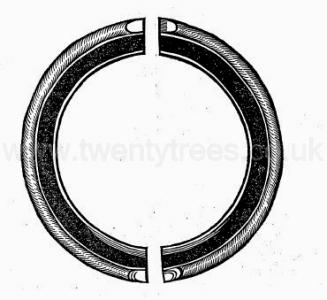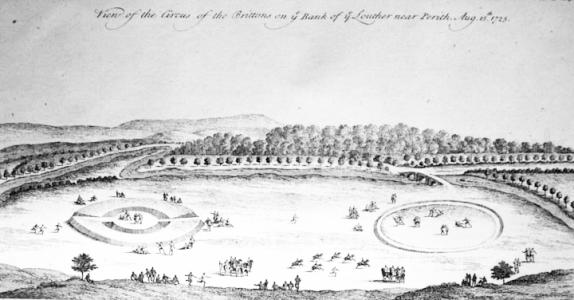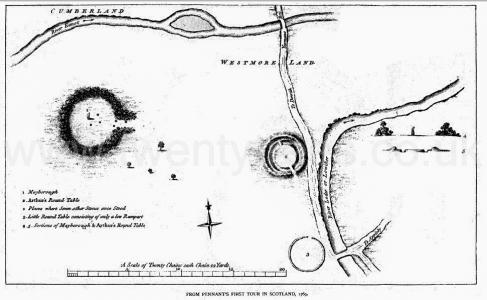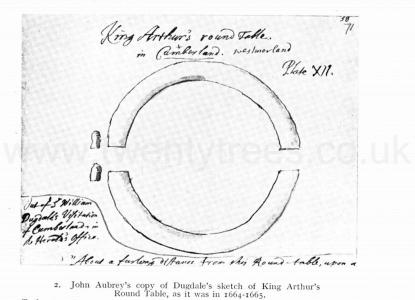Europe, British Isles, North-West England, Cumberland, Eamont Bridge
Eamont Bridge, Cumberland is in Cumberland.
Europe, British Isles, North-West England, Cumberland, Eamont Bridge, King Arthur's Round Table
King Arthur's Round Table is a 90m diameter Henge with a ditch of around 16m. There appears to have been two original entrances.
1586. William Camden, Britain, or, a Chorographicall Description of the most flourishing Kingdomes, England, Scotland, and Ireland
18. Not much higher, and not farre from the confluence of Eimot and Loder, where is seene that round trench of earth which the country people tearme Arthurs Table, stands Penrith, which is, if you interpret it out of the British language, The red head or hill (for the soile and the stones there are of a redish colour), but commonly called Perith.
William Camden's plan of King Arthur's Round Table.

Avebury by William Stukeley. PENRITH. At the conflux of the rivers Louther and Eimont there is a remarkable curiosity, that illustrates the method of the religious solemnities of the old Britons, as much as any I have seen. Upon the edge of the Louther, where the bridge now passes it, is a delicate little plain, of an oblong form, bounded on the other slde by a natural declivity: this is used to this day for a country rendezvous, either for sports or military exercises, shooting with bows, &c. On this plain stands the antiquity commonly called King Arthur’s Round Table, and suppofed to be used for tilts and tournaments: it is a circle inclosed with a ditch, and that with a vallum. At first sight we may see that it was intended for sports, but not on horseback, because much too little: the vallum on the outside lies sloping inward with a very gradual declivity, on purpose for spectators to stand around it; and it would hold at least 10,000 people. The outside of the vallum is pretty steep: it was high originally, as may be seen now in some parts; but it is worn down, as being by the side of the common road; and the inhabitants carry it away to mend the highways withal. There are two entrances into the area, north and south, or nearly so: one end is inclosed into a neighbouring pasture: the area had a circle within, somewhat higher in elevation than the other. The outer verge of the vallum is a circle of 300 foot: the composition of it is intirely coggles and gravel, dug out of the ditch. Upon part of the plain are marks of the tents of the Scots army, that accompanied King Charles II in his way to Worcester: they encamped here for some time, and drew a small line across part of the southern circle: this was done within memory.
1725. William Stukeley (age 37) sketched King Arthur's Round Table, Mayburgh Henge [Map] and Little Round Table.

1769. Pennant sketch of Mayburgh Henge [Map] and King Arthur's Round Table.

Transactions of the Cumberland and Westmorland Antiquarian and Archaeological Society Volume 40 Pages 169 to 206. IN 1938 Professor R. G. Collingwood produced, in these Transactions (xxxviii, 1-31), an Interim Report on the excavations of 1937 at King Arthur's Round Table. Illness prevented him from completing the task, and the final investigation was conducted by the writer, to whom it had been entrusted, between 10th July and 27th August, 1939. Eight workmen were employed throughout, while the experienced Mr. W. Cruddas of Greenhead acted again as foreman. Mrs. Spence undertook the task of Excavations Secretary and Guide, and superintended the filling-in during the anxious days preceeding the outbreak of war. Dr. J. E. Spence devoted the first week of his vacation to joint direction, while Miss M. Cross and Miss K. S. Hodgson gave voluntary help in the more delicate tasks. It was particularly useful to have Mrs. Collingwood's presence for a week during the excavation. Mr. Hay and Dr. Goodchild gave much valuable advice on geological problems. Mr. R. Morton Rigg, as during the first season, undertook the organisation of labour and tools most generously lent by the Penrith Urban District Council. Captain Anthony Lowther, on behalf of Lowther Estates Limited, kindly extended permission to excavate, with the consent of the tenant, Mr. W. Bainbridge of the Home Farm; while H.M. Office of Works authorised excavation of a scheduled monument, a visit being paid by Inspector P. K. Baillie-Reynolds. To all these helpers and to Major Porter, I offer heartiest thanks for their assistance. Among many visitors I had the pleasure of welcoming Messrs. Grahame Clark and J. F. Grimes. Finally three trenches were made through the so-called Little Round Table (see Appendix) and, in co-operation with H.M. Office of Works, the surviving standing-stone in the adjacent circle at Mayburgh [Map] was secured against collapse.
Results of the Excavation. Plate E. John Aubrey's copy of Dugdale's sketch of King Arthur's Round Table. The notre reads "Out of William Digdale's Visitation of Cumberland in Herald's Office.

Europe, British Isles, North-West England, Cumberland, Eamont Bridge, Little Round Table
Little Round Table is a Henge two hundred metres south of King Arthur's Round Table; it is mostly destroyed
Avebury by William Stukeley. Just 400 foot from the verge of the south entrance is another circle [Little Round Table], 300 foot in diameter, made contrary wise to the former: the vallwn is small, and the ditch whence it was taken is outermost. Thus these two circles and the interval make 1000 foot in length; and there is just room enough without them, next the river and next the bank, for a circus or foot-race, according to the old manner of the Grecian, which were always celebrated by the sides of rivers.
Centum ego quadrijugos agitabo ad flumina currus, &c. Virg. and probably Britilh chariots had here their courses. On the southern end it is manifest they contrived it just to leave room enough for the turn; and it required good sklll to drive a chariot so as not to fall there, or into the river. It must be understood, that the bridge at present, and another of wood formerly a little below it, have impaired the banks by the more southern circle. This is the most delightful place that can be imagined for recreation; the rapid river Louther runs all along the side of it; the Eimot joins it a little way off, in view: beyond is a charming view of a vast wood, and of Brougham castle [Map]; beyond that, the ancient Roman city, and the Roman road going along under the high hill whereon is the beacon. But these are things later in time than our antiquity.
1725. William Stukeley (age 37) sketched King Arthur's Round Table, Mayburgh Henge [Map] and Little Round Table.

Transactions of the Cumberland and Westmorland Antiquarian and Archaeological Society Volume 40 Pages 169 to 206. IN 1938 Professor R. G. Collingwood produced, in these Transactions (xxxviii, 1-31), an Interim Report on the excavations of 1937 at King Arthur's Round Table. Illness prevented him from completing the task, and the final investigation was conducted by the writer, to whom it had been entrusted, between 10th July and 27th August, 1939. Eight workmen were employed throughout, while the experienced Mr. W. Cruddas of Greenhead acted again as foreman. Mrs. Spence undertook the task of Excavations Secretary and Guide, and superintended the filling-in during the anxious days preceeding the outbreak of war. Dr. J. E. Spence devoted the first week of his vacation to joint direction, while Miss M. Cross and Miss K. S. Hodgson gave voluntary help in the more delicate tasks. It was particularly useful to have Mrs. Collingwood's presence for a week during the excavation. Mr. Hay and Dr. Goodchild gave much valuable advice on geological problems. Mr. R. Morton Rigg, as during the first season, undertook the organisation of labour and tools most generously lent by the Penrith Urban District Council. Captain Anthony Lowther, on behalf of Lowther Estates Limited, kindly extended permission to excavate, with the consent of the tenant, Mr. W. Bainbridge of the Home Farm; while H.M. Office of Works authorised excavation of a scheduled monument, a visit being paid by Inspector P. K. Baillie-Reynolds. To all these helpers and to Major Porter, I offer heartiest thanks for their assistance. Among many visitors I had the pleasure of welcoming Messrs. Grahame Clark and J. F. Grimes. Finally three trenches were made through the so-called Little Round Table (see Appendix) and, in co-operation with H.M. Office of Works, the surviving standing-stone in the adjacent circle at Mayburgh [Map] was secured against collapse.